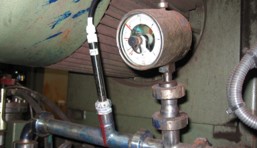Diffuse Reflectance PROBE For In-Line Color Measurement
INTRODUCTION
Color spectrophotometers are designed to measure solids and liquids under controlled conditions in a laboratory. In this product control technology, samples are brought to the spectrophotometer. Acceptance sampling is used to detect defects and control the quality of an entire lot or batch of products. Product control generates after-the-fact data and does not allow for immediate process adjustments.
With the advent of fiber optics, new technologies have been developed that make in-line color measurement in solids, liquids, slurries, pastes, powders, and molten polymers a reality. In this process control technology, the spectrophotometer is brought to the sample. A configured fiber optic probe allows measurements to be taken with or without contact with the sample. Process control generates real-time data detecting off-spec material instantaneously, enabling quality control in real-time, minimizing waste, and lowering production costs.

APPLICATION
The Diffuse Reflectance Probe (DRP) (FIG.1) is ideal for measuring color in liquids, slurries, pastes, and powders. The probe’s versatility makes it suitable for UV-Vis measurement in several industries. For example, the fiber optic probe can be immersed in pressurized tanks and vessels to measure color directly in colorant dispersions (pigments and dyes), such as those encountered in paints, inks, and coating materials. With the DRP, it is also possible to measure color strength in tinting pastes, which the paint industry requires. The DRP can also measure dye batch depletion in the textile industry.
In the chemical industry, unit operations are used to receive, transfer, process, blend, mix, wash, dry, and package raw materials, intermediate and final products. Each unit operation presents an opportunity to alter the color of the product.
Various process analytical technologies, such as pH, dissolved oxygen, turbidity, TOC, conductivity, etc., are used to monitor chemical processes. While each technique is essential and must be observed, one of the most powerful indicators that something is wrong in a particular unit operation is an effluent’s deviation of color from an established standard. Change of color is critical for highly regulated industries such as pharmaceuticals and foods & beverages. This is of critical importance. Thus, in-line color monitoring is a robust process analytical technology to help maintain a process stable and monitor the quality of the intermediate and final products.

Optical
| Sensing Region | Contact to 2 mm |
| Lens/Window Material | Sapphire |
| Numerical Aperture | 0.22 NA |
| Spot Size | 1.5 mm |
| Optical Fiber Type | UV or NIR-7: 6 – (400 microns) fibers around 1 (400 microns) Silica on Silica |
| Fiber Packaging | PVC-coated (80°C) armored fiber bundle. Teflon coated (220°C) armored fiber bundle |
| Fiber Length | 5 meters standard |
| Fiber Termination | SMA 905 |
| Standoff Distance | Contact with Sample |
Physical
| Body & Materials | 316 SS** |
| Body Dimensions | At least 152 mm (6”) length; 19 mm OD (0.75”) |
| Seal Type | Sapphire to metal |
| Seal Material | Sapphire / Nickel Alloy Tip |
| Mounting | 1/2-20 UNF w/5.715mm (0.225”) well depth and 45 degree seat |
| Temperature Range | -20°C to 260°C |
| Maximum Pressure | 138 bar (2000 psi) |
| * Other fiber sizes and/or lengths available upon request ** Other materials available upon request |
